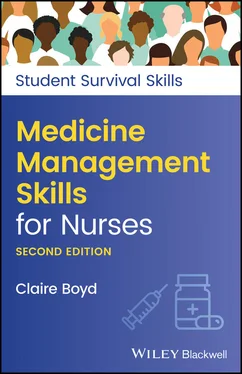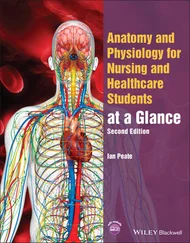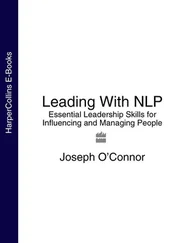Focus on the Task in Hand: Do Not Get Distracted
Many wards and clinical areas have notices on drug trolleys stating Do Not Disturb While Administering Drugs. This enables the member of staff to concentrate on the task in hand. Some institutions have trialled the wearing of tabards in clinical areas for staff administering drugs, alerting others in the area not to disturb them.
Vicarious Liability
Question 1.6
What does vicarious liability mean?
We all need to comply with our Policies and Procedures, whether we work in a hospital, clinic, or the community setting.
Procedure for Administering Medication
So, when administering medications, what is the correct procedure? The person administering a drug before giving it will:
1 Check the identity of the patient,
2 Check for any recorded allergy/sensitivity,
3 Check the drug name, dose form, strength, date, and time,
4 Check the route of administration,
5 Check for any additional instructions, including safety considerations,
6 Check the drug has not already been administered,
7 Check the drug label against the prescription,
8 Check the expiry date of the drug on the label,
9 Calculate the dose if appropriate.
Prescriptions should be written in black pen, clearly, using no drug trade names, and the member of staff should not be distracted from the task in hand. Medical gases should also be prescribed (except in emergency situations).
When administering medications, we should adhere to the so‐called five rights:
Right medicine,
Right dose,
Right route,
Right patient,
Right time.
The procedure for checking the patient's name, name band, and prescription chart is referred to as the three‐point check.
Commonly Used Medicine Name Suffixes
As our knowledge of medicines increase, we will begin to see patterns of drug names related to their drug class, or medicine name suffixes. We can see some of these below in Table 1.4:
 Suffix is a letter or a group of letters that goes at the end of a word.
Suffix is a letter or a group of letters that goes at the end of a word.
Table 1.4 Medicine name suffixes.
| Suffix |
Medication family or class |
Examples of drugs |
Indications for use |
| mab |
Monoclonal antibodies |
Trastuzumab Pertvzumab Pembrolizumab |
Breast cancer Breast cancer Melanoma |
| olol |
b‐Blockers |
Propranolol Bisoprolol Timolol Maleate |
Hypertension Adjunct in heart failure Angina |
| sartan |
Angiotensin receptor antagonists |
Valsartan Telmisartan Irbesartan |
Hypertension Hypertension Hypertension |
| pril |
Angotensin‐converting Enzyme inhibitors |
Lisinopril Ramipril Quinapril |
Hypertension Hypertension Hypertension |
| cillin |
Penicillin antibiotics |
Ampicillin Amoxicillin Benzylpenicillin |
Susceptible infections e.g. bronchitis Susceptible infections e.g. sinusitis Mild to moderate bacterial infections e.g. pneumonia |
| sone |
Corticosteroids |
Prednisone Dexamethasone Hydrocortisone |
Rheumatoid arthritis Cerebral oedema Anaphylaxis |
Before administering any drug to any patient:
Go through the procedural steps for administering medication in your mind,
Go through the five rights,
Know your patient,
Know the drug and its contraindications.
Lastly, do not cut corners. We all have time constraints, but we must always adhere to the Code of Conduct of the Nursing and Midwifery Council (2015) in order to achieve safe, effective, and professional care for our patients.
1 What does STAT mean?
2 What does PRN mean?
3 What are the four parts of the medication process?
4 What route of administration is referred to if you see INH on a prescription chart?
5 5 A drug is presented as 1 g in 100 ml. A patient weighing 90 kg is prescribed 20 mg/kg/h of the drug.How many milligrammes per hour of the drug does the patient require?For how many millilitres per hour do you set the infusion pump?
6 What are the five rights in regard to drug administration?
7 How many medication errors are there estimated to be in the NHS per annum?
8 According to the BNF, children have been classified into four groups/What are they?
9 If you saw the drug suffix ‘olol’ what medication class do these drugs belong to?
10 What does ADME stand for?
Latin abbreviations used in drug administration.
Using your professional judgement.
The medication process.
The routes of drug administration.
Examples of drug administration competencies to be signed off during placements.
Looking at the front sheet of the prescription chart.
Improving medication safety factors.
The procedure for the administration of medicines.
BNF for Adults: www.bnf.nice.org.uk
BNF for Children: www.bnfc.nice.org.uk
Electronic Medicines Compendium: www.medicines.org.uk/emc
NMC: www.nmc.uk.org
Government publications: www.gov.uk/government/publications/public‐spending‐statistics
www.legislation.gov.uk
www.england.nhs.uk/patient‐safety/national‐medicines‐safety‐programme
www.gov.uk/government/publications/medication‐errors‐short‐life‐working‐group‐report
www.npsa.org.uk
www.gov.uk/government/publications/the‐national‐patient‐safety‐agency‐annual‐report‐and‐account
www.england.hns.uk/patient‐safety/national‐medicines‐safety‐agency‐7‐key‐actions‐to‐improve‐mrdication‐safety
Electronic Medicines Compendium: www.medicines.org.uk
National Patient Safety Agency: www.npsa.nhs.uk
1 The Royal Marsden Manual of Clinical Nursing Procedure (2020) (eds. Sara Lister, Justine Hofland, and Hayley Grafton. 10. Wiley
2 NMC (2015) The Code. Professional Standards of Practice and Behaviour for Nurses, Midwives, and Nursing Associates. London. www.nmc.org.uk
Конец ознакомительного фрагмента.
Текст предоставлен ООО «ЛитРес».
Прочитайте эту книгу целиком, купив полную легальную версию на ЛитРес.
Безопасно оплатить книгу можно банковской картой Visa, MasterCard, Maestro, со счета мобильного телефона, с платежного терминала, в салоне МТС или Связной, через PayPal, WebMoney, Яндекс.Деньги, QIWI Кошелек, бонусными картами или другим удобным Вам способом.

 Suffix is a letter or a group of letters that goes at the end of a word.
Suffix is a letter or a group of letters that goes at the end of a word.










